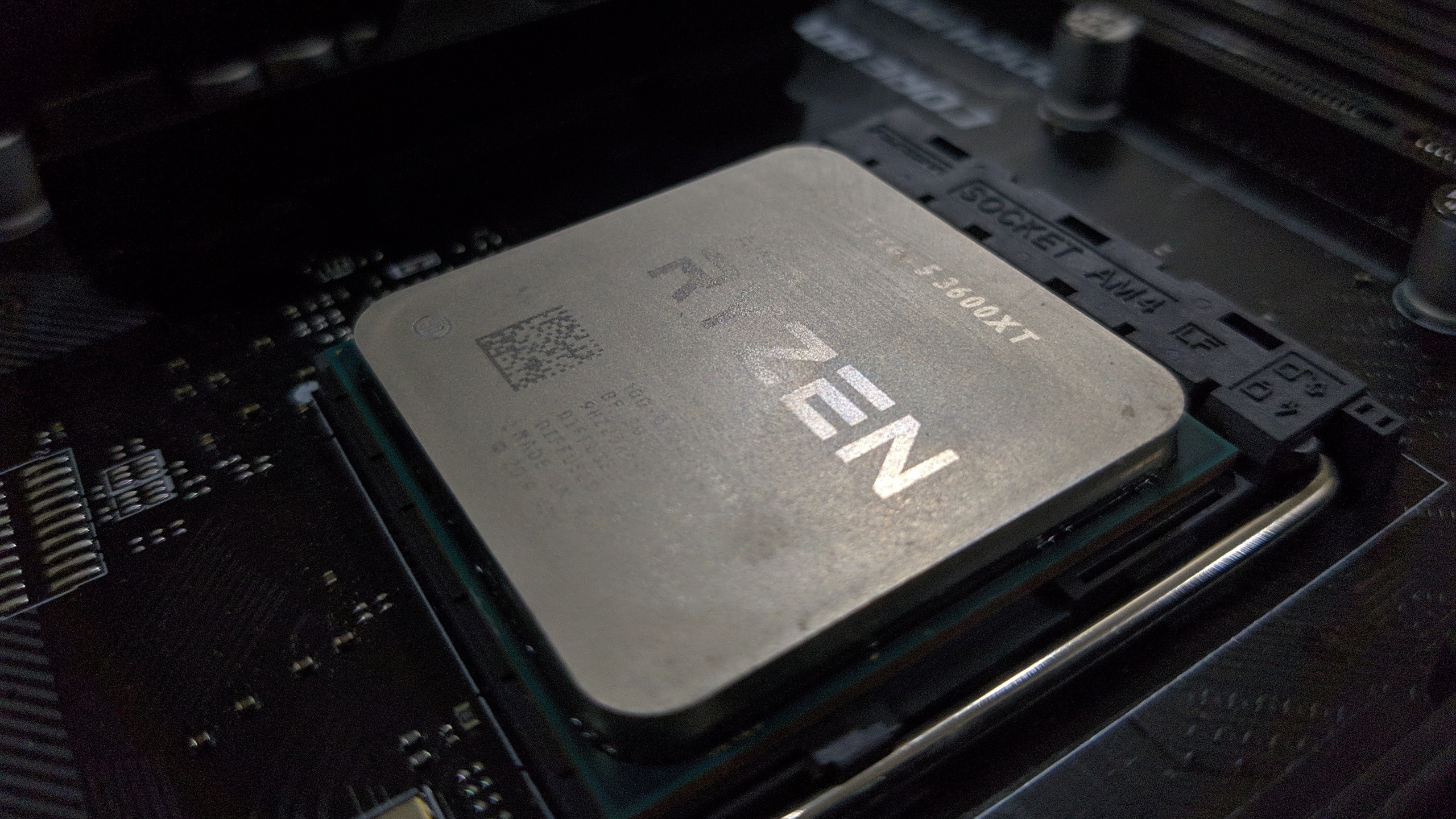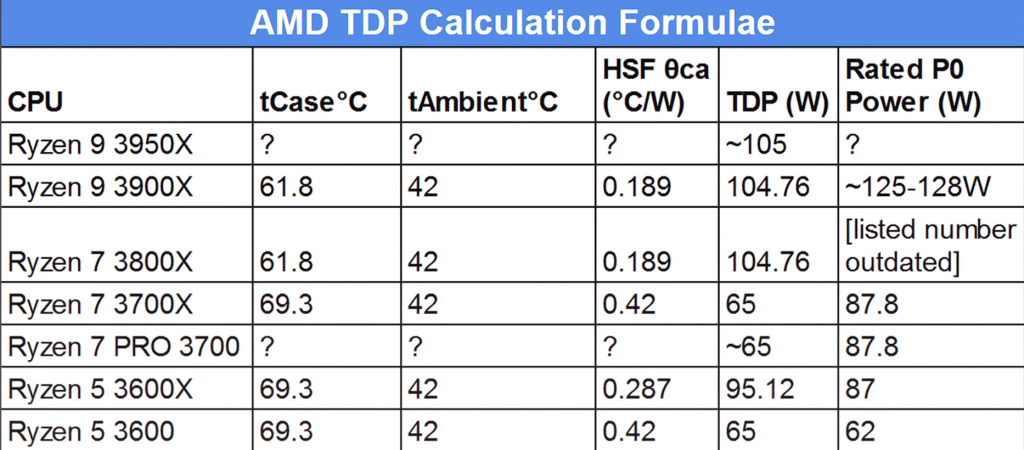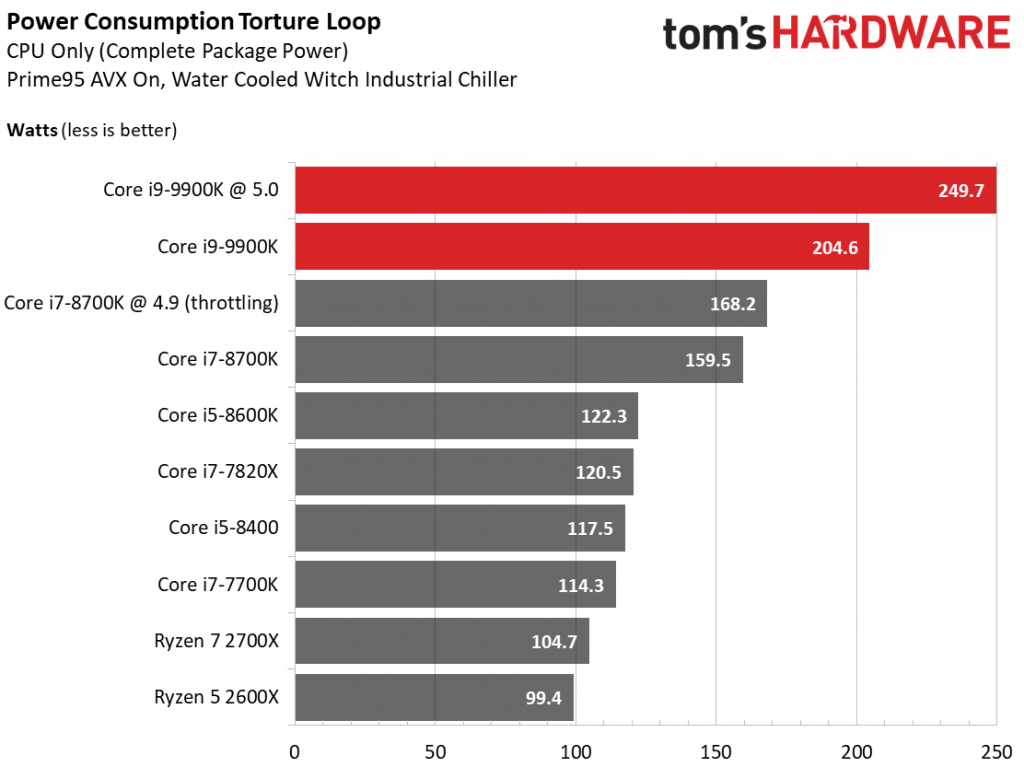How Processor TDP Ratings Can Be Misleading
If you have ever been in the market for a CPU, there is a solid chance that you might have come across a little rating known as TDP. This is a rating that is often thrown around in arguments or recommendations and it is actually quite widely misunderstood. TDP stands for “Thermal Design Power” and it is a specification that can be found on pretty much any processor nowadays. It is measured in “Watts” and is meant to tell the user about the maximum amount of heat the processor is expected to output in a realistic but heavy load scenario. The two major CPU manufacturers, AMD and Intel, use this number extensively throughout their marketing material.

Understanding TDP
So why exactly is this TDP rating so hard to understand? Well, a major part of it has to do with the fact that the TDP is not a tightly regulated rating. This rating is used by Intel and AMD to refer to the amount of heat the CPU cooling solution must dissipate from the CPU in order to keep it under TJmax. This creates a lot of gray area in the definition of TDP, because of the variations introduced through the CPU Boost Algorithms and the variety of cooling solutions.
TDP is also confusing due to the fact that it is advertised in Watts. Upon seeing this rating in watts, one can easily assume that this refers to the amount of power that the processor is meant to draw, which is a misleading concept. TDP actually refers to the “Thermal Power Output” rather than “Electrical Power Draw” which creates a new misconception among the common buyer.
Heat vs Power
Contrary to popular belief, the TDP rating does not, in fact, refer to the maximum amount of power that the processor can draw under load. It is not even a measure of electrical power at all. TDP is a number that is “chosen” by AMD and Intel rather than calculated, and its ultimate goal is a mixture of useful information and marketing.
TDP is a number that is selected to allow cooler manufacturers to devise a cooling solution that can be capable of keeping the said processor within its normal operating temperatures in all normal use-case scenarios. Therefore, it is more geared towards the cooling of the processor rather than the power that the processor can draw under certain conditions.
However, there is a link present between the thermal power rating that can be seen here and the actual power that the processor can draw. While the TDP number itself might not be the direct indicator of power draw, it can indirectly be useful in comparing the power draw of two processors using the same manufacturing process and based on the same architecture. Since the processor with the higher TDP rating would produce more heat under load, chances are that it tends to draw more power from the power supply as well. Thus we can say that the numbers are linked, but saying that a processor with a TDP rating of 95 Watts will consume 95 watts of power under load is just inaccurate.
A Watt is a Watt
Despite the apparent differences between the thermal power output and electrical power draw, a watt is still a watt. Wikipedia defines the watt as “a derived unit of one joule per second, and is used to quantify the rate of energy transfer”. This definition is especially useful to explain the use of the unit “watt” in TDP ratings.
The power drawn by the component is measured in watts, while the heat output of the processor is also measured in watts. It is important to remember that these are not different units that share the same name. The usage of watt signifies that the same energy is being converted from thermal to electrical form. This means that the energy that is drawn by the processor (the electrical power) will always be somewhat higher than the energy that is being released by the processor in the form of heat (thermal power). The difference in energy between these two quantities is used by the processor to perform its function.
How Intel calculates TDP
The misconceptions regarding the TDP ratings have become even more widespread due to the fact that both of the big CPU manufacturers use different ways to select their TDP. This means that their numbers, while both measured in watts, are not comparable to each other. The important differentiation is that Intel uses its processors’ base clock to select its TDP. This means that the “maximum heat output” rating of their processors is only valid when the CPU is operating at the base clock.
This presents a multitude of challenges in modern scenarios. The modern CPUs from Intel rarely operate at the base clock. Due to extensive boosting mechanisms integrated into the modern chips, and even more, overclocking headroom unlocked by the motherboard features like Multi-Core Enhancement, the advertised TDP rating falls well below the actual power draw of the chip during regular use. The TDP is a rather tame estimation of the heat output of the processors when it comes to Intel.

This can also present a challenge to the end-user in terms of the choice of components. An unsuspecting buyer might be inclined to buy a smaller PSU or a weaker CPU cooler if the consideration is based on TDP alone. While it is possible to run the CPU with a cooler that is rated for its exact TDP (95W cooler for a 95W rated CPU), the CPU will definitely shoot past its rated TDP as soon as any turbo-boosting mechanisms are activated. This can present problems in terms of cooling. Therefore, Intel’s approach to the TDP ratings of its processors is a bit muddier than AMD’s, and therefore leaves more room for interpretation.
How AMD calculates TDP
AMD is, by no means, perfect when it comes to the process of assigning TDP ratings to its CPUs. The big upside to AMD’s approach, however, is that AMD measures the heat output of the processor at its maximum boost clock, as opposed to Intel’s approach where it is measured at the base clock. This can be a somewhat more accurate indication of the amount of heat that the CPU can output in regular use cases.

It has been reported that AMD’s internal definition of TDP is: “Thermal Design Power (TDP) is strictly the measurement of an ASIC’s thermal output, which defines the cooling solution necessary to achieve rated performance.” This statement is pretty straightforward in essence. AMD is outlining the basic requirements of a TDP rating for an ASIC (Application-Specific Integrated Circuit, or Ryzen CPUs in this context). This guideline by AMD offers a bit more information to the cooler manufacturers so that they can design an adequate cooling solution for the CPUs in question.
There is one confusing part in the statement by AMD though. AMD refers to the processor’s “rated performance” in its definition of TDP. This basically means that the TDP rating is only valid for processors operating between their base and boost frequencies. This rules out the potential auto-overclocking feature of Precision Boost 2.0 which uses thermal and power headroom to achieve the maximum boost clocks that the processor is able to hit, without breaching any power and thermal limits.
AMD’s approach also includes a formula for TDP that can potentially help cooler manufacturers to adequately design their cooling solutions.
TDP Formula
The formula given by AMD for TDP is as follows:
TDP (Watts) = (tCase°C – tAmbient°C)/(HSF θca)
GamersNexus broke down this formula in their reporting, let’s see what it means:
- tCase°C is defined as follows: “Maximum temperature for the die/heat-spreader junction to achieve rated performance”. It has been reported that AMD’s internal definition is this: “Maximum case temperature. The maximum temperature when measured at the package location specified by the appropriate thermal design guide.” Tcase max is used for thermal solution design and in thermal simulations.
- tCase means “case,” as in integrated heat spreader or IHS, not the chassis of the computer. Particularly, this refers to the temperature at the point where the silicon die meets IHS. Note that this isn’t “how hot does the CPU get” but “how hot can the CPU get before Precision Boost 2 starts to throttle back.” Lower tCase would beget lower TDP in the formula.
- The next number in the formula is tAmbient, which is the subtrahend deducted from the minuend tCase before the result is divided by thermal resistance. AMD defines tAmbient°C as the “maximum temperature at the HSF fan inlet to achieve rated performance.”
- HSF refers to the heatsink and fan, so the CPU cooler mounted on top of the processor. This is the temperature of the air around the heatsink, whether it’s on an open bench or in a PC case. Lower tAmbient means higher TDP, but tAmbient is defined by AMD in its TDP formula and is not defined by your own tAmbient. AMD defines HSF θca (°C/W) as: The minimum °C per Watt rating of the heatsink to achieve rated performance.

Does the formula hold substance?
Having a specific formula for this use case might seem like the perfect solution to the misconceptions around TDP but it is in fact, far from it. Firstly, it should be noted that none of the values in the formula are fixed. All of the values are variables that change with the processor in question. This means that numbers can be manipulated at will to get the desired TDP value, and the TDP value can be manipulated just to get the arbitrarily defined numbers on the right-hand side. This is why it was stated that the TDP values are “selected” more than “calculated” by Intel and AMD.
But let us look at the formula to see what it actually means. Surely there would be something substantial behind a mathematical equation? Well, it turns out that there is in fact, some use of this formula in the process of manufacturing a cooler for the CPU. The formula essentially covers the factors that would be necessary to achieve the selected TDP target by the CPU manufacturer. The variables within the formula do not hold any importance to the end-user though.
Until now it might seem like TDP numbers are just some promotional jabber that the companies are putting on their CPU boxes just to mislead the consumer. However, that is not entirely the case. The matter of fact is, AMD and Intel never claimed that the TDP is meant to indicate the power draw of the CPU. They specifically list the TDP as an indicator of thermal power output, and as a guide for the cooler required to dissipate the heat from the CPU. The misconceptions around TDP stem from many factors, most notably the use of “watts” to represent thermal power, which can be easily misunderstood.
How TDP numbers are useful
You might be inclined to think that the TDP numbers that are put out by AMD and Intel have no meaning to the end-user. That statement might be true to some extent, but it does not mean that the TDP numbers are entirely useless. There are two big advantages to this approach:
Different processors at the same TDP
The first big advantage of devising a TDP rating for the processors is that AMD and Intel can work on the other variables in the TDP formula to achieve the desired TDP target. It was explained earlier that the variables in the formula could be manipulated at will to achieve the desired result. This might not be such a bad thing in practice. In reality, this means that the manufacturer can select a reasonable TDP for their component, and then fine-tune the internals of the component to deliver that desired result. This is a somewhat oversimplified explanation of why that formula is so open to manipulation.
The variables in that formula vary from CPU to CPU, while we can see multiple CPUs from both AMD and Intel which share the same TDP. For example, the Ryzen 7 3800X, Ryzen 9 3900X, and Ryzen 9 3950X all share the same TDP of 105 watts. It is clear to everyone immediately that the Ryzen 9 3950X consumes the most amount of power out of all the CPUs that share this TDP. This is because AMD has achieved that target TDP by manipulating and fine-tuning the other values in the formula, to get the best thermal transfer and thermal efficiency at a higher power draw.
Devising Cooling Solutions
The second major advantage of TDP ratings is actually the main reason the TDP numbers were selected in the first place. Since TDP is the number chosen by Intel and AMD to refer to the amount of heat that the cooler must be able to dissipate for the CPU to work as intended, this value actually helps the cooler manufacturers to devise adequate cooling solutions for the CPUs. This ensures that the CPUs that are being put out by the manufacturers have adequate coolers available in the market from both first-party and third-party manufacturers.

When a new CPU is announced, AMD/Intel sends a detailed document to the cooler designers called the “Thermal Design Guide”. This guide contains all the necessary information about the chip in question, including the method used to “calculate” the TDP for that processor. Any and all adjustments that have been made to the formula are also noted in the guide so that the cooler manufacturer can adjust for the manipulations as well. The manufacturers are then free to devise their own cooling solutions, which are then subjected to rigorous testing with the CPUs in question. This testing ensures that the cooler is capable of ensuring that the chip runs at its rated performance level, without breaching TJmax.
Cooler Manufacturers on TDP
The manufacturers of these cooling solutions are also polarized on the topic of TDP. It is evident that none of them actually trust the numbers that are put out by AMD and Intel for their CPUs. Due to the level of adjustment and manipulation to the TDP formula, and the variation in power draw and thermals due to boosting techniques, the cooler manufacturers pay little heed to the actual number. The manufacturers tend to validate the working of the coolers through their own testing on the CPUs in question.
You might have noticed that coolers have a TDP rating advertised as well. This is another TDP number that does not hold much substance when it comes to real-world operations. If a cooler is rated for 95W TDP, it does not necessarily mean that it would be able to cool a processor that is also rated at 95W. There are just too many variables at play here to make a definitive blanket statement like that. Cooler manufacturers actually test out and devise their own TDP ratings for their coolers which may or may not comply with the ratings that AMD and Intel have put out.
Thermal testing and proper reviews should be your only reference point when buying a cooler for your CPU. TDP ratings of both the CPU and the cooler may only just be good at confusing the potential buyer.
If not TDP, then what?
If you’re concerned about the power draw of any CPU that you may be considering to buy, there is a way to find out exactly that. Instead of depending on made-up TDP numbers that offer little-to-no real-world indicators of power draw, one should always look at in-depth reviews and thermal performance of a particular CPU before buying. The TDP does not tell the whole picture. It can be quite misleading to customers who just see “watts” printed next to a number and assume that it’s the maximum power draw rating.
Full in-depth reviews of CPUs and other components generally include the power draw numbers which are measured both from the ATX 12-pin CPU connector and also from the wall. This gives a very accurate idea about the power draw of the CPU under different scenarios. Unlike the TDP numbers, the power draw numbers that are calculated this way are fairly representative of the actual numbers you might expect to see in normal operation. These values also take into account the boosting algorithms and any out-of-the-box OC enhancements that might be activated on certain CPUs. Judging the power draw of a CPU this way is far more accurate and representative of actual real-world results than just estimating the power draw from the TDP ratings.

Final Words
In conclusion, it is pretty obvious that the TDP numbers are not representative of the power draw of a CPU in real-world scenarios. The TDP is a rating that is more flexible than most people realize. Mostly it is a number that is selected by AMD and Intel to give cooler manufacturers a certain target, around which they have to design their cooling solutions. There is a lot of room for interpretation in this rating, and thus it leads to a large amount of misconception. TDP is by no means an accurate representation of the maximum power draw of a CPU as most unsuspecting buyers might assume.
The rating has its uses in some instances, however, that is more concerned with the cooling of the CPU as opposed to power draw. Cooler manufacturers also do not agree with the use of TDP numbers and formulae by both Intel and AMD. They devise their own methodology and testing to check whether the cooling solution they produced is adequate for a certain CPU. It can also be inaccurate to directly compare the TDP numbers of one CPU to another one, simply because they both use “watts” in their rating system. The end-user should always take the reviews into account before making a purchase decision.





